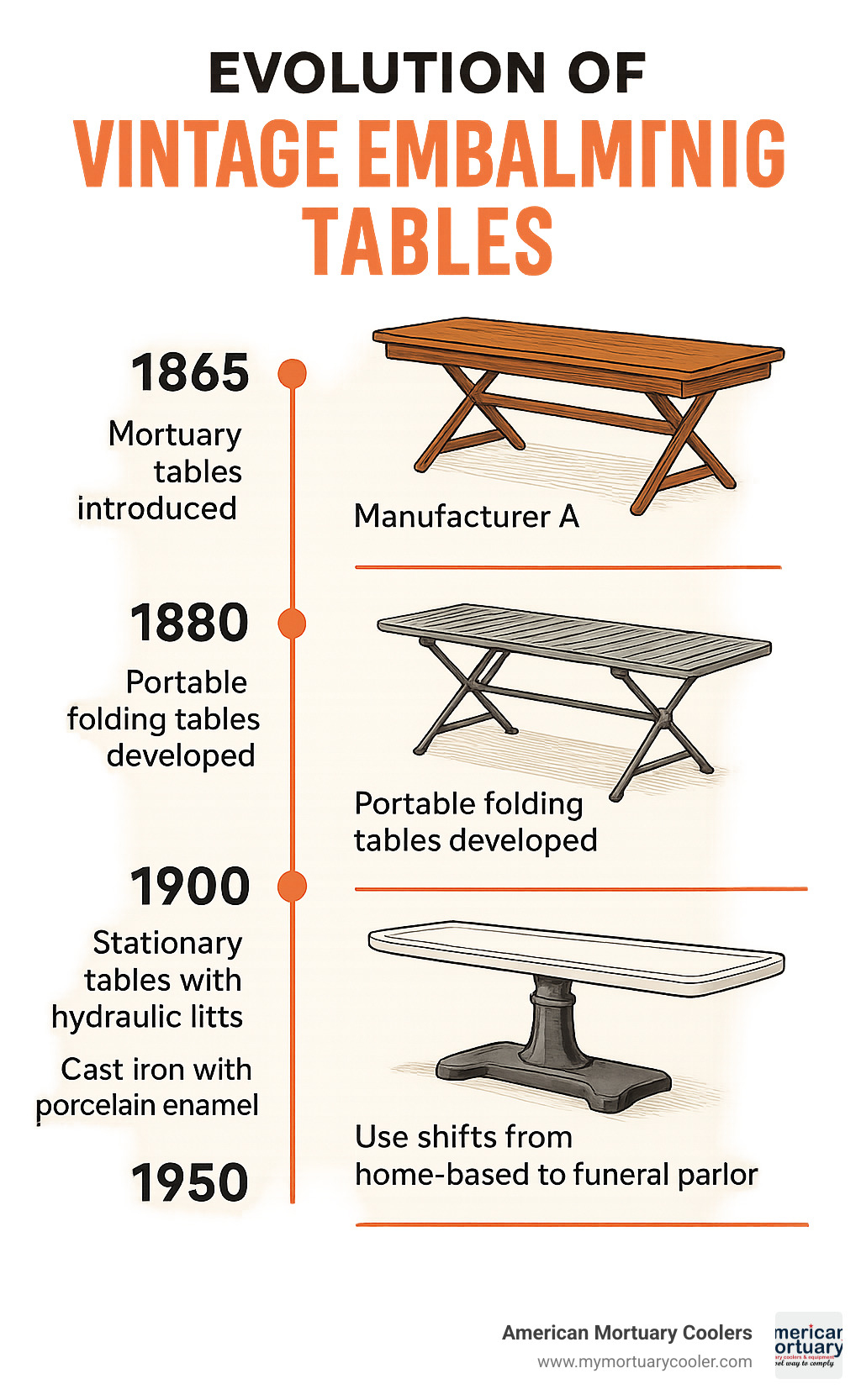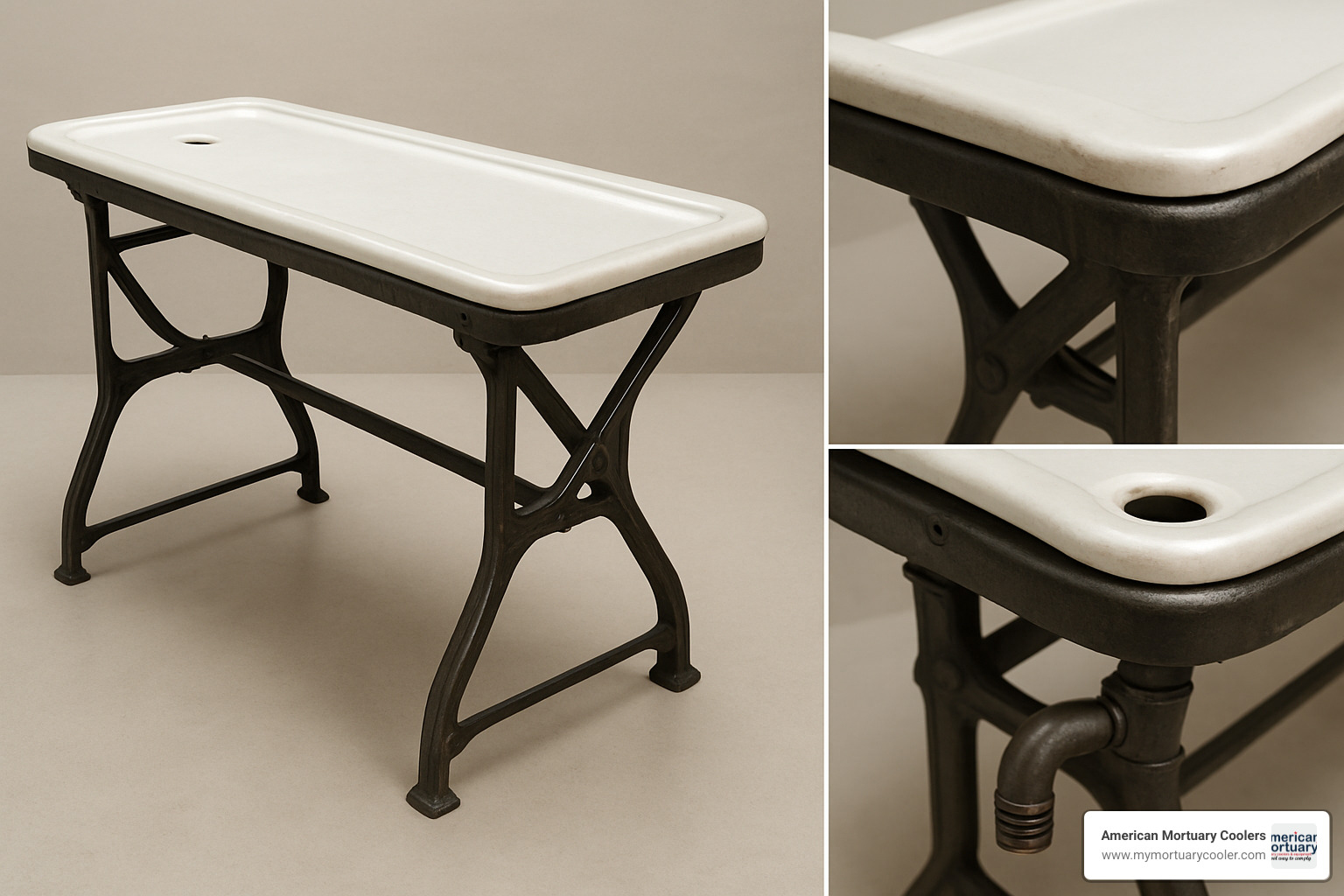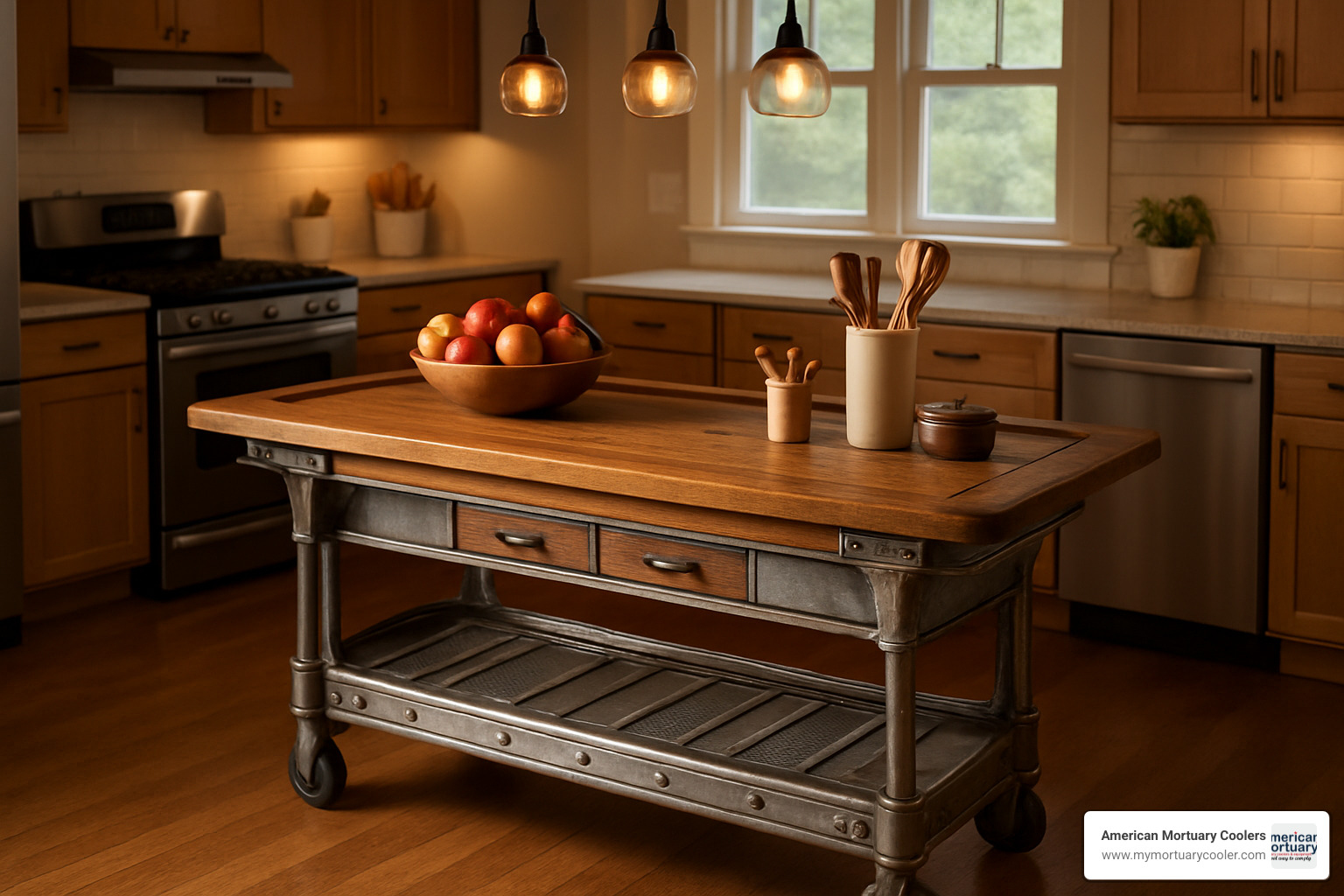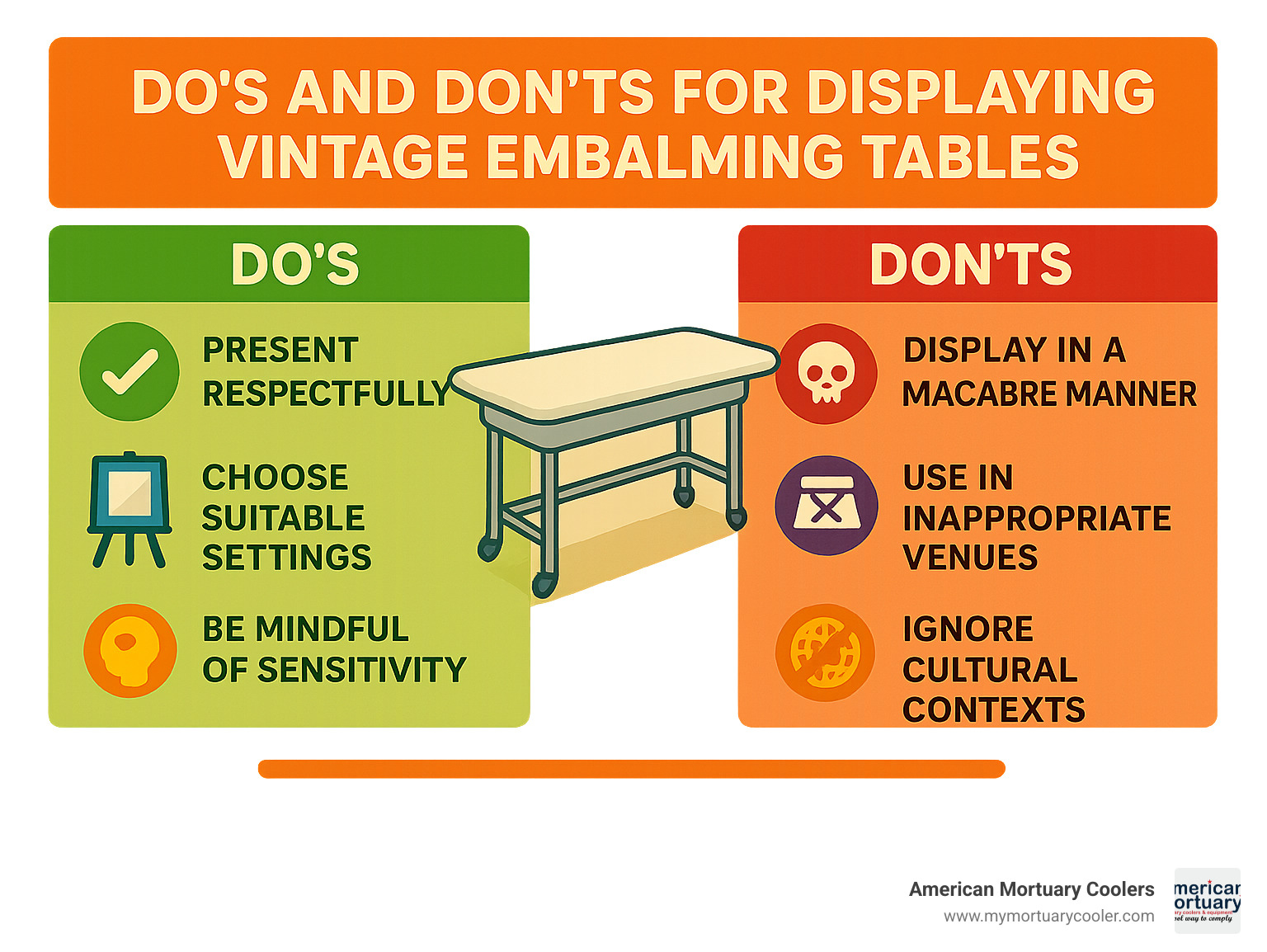Why Vintage Embalming Tables Are More Than Just Antique Furniture
A vintage embalming table represents a fascinating piece of American funeral history that dates back to the post-Civil War era. These specialized pieces of mortuary equipment tell the story of how death care evolved from home-based practices to professional funeral services.
Key Facts About Vintage Embalming Tables:
- Era: Primarily 1860s-1950s, with peak production 1880-1930
- Materials: Cast iron frames, porcelain enamel surfaces, copper-sheeted tops, hardwood construction
- Dimensions: Typically 75" long × 25" wide × 25-34" high
- Weight: Portable models under 30 lbs, stationary models 60-80+ lbs
- Price Range: $1,000-$6,000 depending on condition, rarity, and provenance
- Notable Makers: Gleason Board Company, Ferno, Embalmers' Supply Co.
The story begins with a simple need. "After the Civil War it became popular for undertakers to come to the home of the deceased to ply their trade," explains historical documentation from the era. This shift created demand for portable, sanitary equipment that could travel from house to house.
Early vintage embalming tables were engineering marvels of their time. The Gleason Board Company's 1880 portable model weighed just under 29 pounds when folded, yet could support a full-sized adult. These tables featured walnut construction with copper sheeting for easy cleanup - a design that prioritized both portability and sanitation.
What makes these tables truly special isn't just their historical significance. They represent the intersection of craftsmanship, medical innovation, and changing social customs around death care in America.
As experts in mortuary equipment at American Mortuary Coolers, we've worked with funeral directors across our service regions - from Tennessee to California - who collect and restore vintage embalming tables alongside their modern equipment needs. Our experience in the mortuary industry has given us insight into both the historical significance and practical considerations of vintage embalming table ownership.

What Is a Vintage Embalming Table?
Picture this: It's 1870, and an undertaker loads his horse-drawn buggy with a peculiar piece of equipment that folds like a carpenter's workbench. This vintage embalming table represents one of the most significant innovations in American funeral history.
A vintage embalming table served as the centerpiece of death care during America's change from home-based mourning rituals to professional funeral services. These specialized tables, manufactured primarily between the 1860s and 1950s, were designed for preparing and preserving human remains with both dignity and efficiency.
The Civil War changed everything about how Americans dealt with death. Families desperately wanted their fallen soldiers returned home for burial, but transportation took weeks or even months. This heartbreaking reality sparked innovation in embalming techniques and created the first real market for portable, reliable embalming equipment.
Before the war, most families simply laid out their deceased loved ones in the home parlor. But the scale of Civil War casualties and the distance between battlefields and hometowns demanded a more sophisticated approach. Enter the vintage embalming table - a solution that would reshape the funeral industry forever.
Origins in Post-Civil War America
The vintage embalming table industry was born from genuine human need. The Gleason Board Company recognized this opportunity and pioneered the portable embalming table around 1880. Their ingenious design featured walnut construction with copper tops that could fold for transport.
These early models were marvels of practical engineering. When unfolded, they measured a full 75 inches long - plenty of room for adult remains. But here's the clever part: they compressed to just 38 inches long by 19 inches wide when folded. Perfect for fitting in the back of an undertaker's buggy alongside other essential supplies.
The 1860s through 1880s saw explosive demand for these innovative tables. Undertakers needed equipment that could handle house calls while maintaining professional standards. The combination of portability and sanitation made these tables indispensable for the growing funeral trade.
Families appreciated having a proper, clean surface for their loved one's preparation. It was far more dignified than makeshift arrangements on kitchen tables or barn doors - unfortunately common practices before professional embalming tables became available.
From Home Parlors to Funeral Homes
As America industrialized and cities grew larger, something interesting happened. The funeral industry began shifting from home-based services to dedicated funeral parlors. This transition, occurring primarily between 1890 and 1920, completely changed how vintage embalming tables were designed and used.
The move to purpose-built preparation rooms meant tables no longer needed to be portable. Funeral directors could invest in larger, more elaborate equipment with advanced features. Cast iron frames replaced wood construction, while porcelain enamel surfaces offered superior sanitation compared to copper sheeting.
This shift allowed for stationary models with impressive innovations: hydraulic lifts for height adjustment, built-in drainage systems, and tables that could tilt at various angles. These improvements made the embalming process more efficient and much more sanitary - a crucial consideration as germ theory gained acceptance in medical practice.
The change from portable cooling boards to sophisticated stationary equipment mirrors the broader professionalization of funeral service during this era. What started as a practical solution for house calls evolved into the foundation of modern mortuary science.
Key Features & Materials of Antique Embalming Tables

When you examine a vintage embalming table, you're looking at a masterpiece of practical engineering. These tables weren't just furniture - they were precision tools built to last generations. The craftsmanship that went into each piece reflects the pride funeral professionals took in their work.
The foundation of most antique tables started with cast iron frames. This material choice wasn't accidental. Cast iron provided the rock-solid stability needed for delicate work while resisting the harsh chemicals used in embalming. Many tables from the 1890s still stand sturdy today, a testament to this smart material choice.
Porcelain enamel surfaces became the gold standard by the early 1900s. These smooth, glass-like coatings offered something for their time - complete chemical resistance and easy cleaning. Unlike wood or bare metal, porcelain enamel wouldn't absorb fluids or harbor bacteria. It was the iPhone of mortuary innovation.
Earlier models often featured copper-sheeted tops instead of porcelain. Copper naturally resists corrosion and can be cleaned quickly between uses. The Gleason Board Company used this approach in their famous portable models, creating a surface that stayed sanitary even with heavy use.
For portable models, slatted hardwood construction was genius engineering. By using carefully spaced wooden slats instead of solid surfaces, manufacturers cut weight dramatically while maintaining strength. These folding designs could support a full-sized adult yet weighed under 30 pounds.
The hardware details reveal the quality of these pieces. Brass hinges, locks, and adjustment mechanisms were standard on better models. Brass doesn't rust like iron, and it polishes to a professional shine that impressed grieving families.
| Feature | Vintage Tables (1880-1940) | Modern Tables (1950+) |
|---|---|---|
| Material | Cast iron, porcelain, copper | Stainless steel |
| Weight | 29-80 lbs | 80+ lbs |
| Adjustment | Manual ratchets | Hydraulic systems |
| Portability | Folding designs common | Stationary with wheels |
| Drainage | Simple gutters | Integrated plumbing |
Sanitation & Ease-of-Use Design
The late 1800s brought a revolution in medical understanding. Germ theory changed everything, including how vintage embalming tables were designed. Suddenly, every surface, every joint, every feature had to consider bacterial growth.
Angled drainage systems became standard features. These weren't just simple gutters - they were carefully engineered slopes that moved fluids away from work areas. The best tables had removable trays that could be taken out, scrubbed clean, and sanitized separately.
Hand-pump lifts appeared on higher-end models by the 1910s. These mechanical systems let funeral directors adjust table height without touching potentially contaminated surfaces. Some tables even included early water control units - primitive but effective systems for rinsing and cleaning.
The influence of germ theory shows in every design choice. Smooth surfaces replaced ornate details. Sharp corners gave way to rounded edges that couldn't trap debris. Everything about these tables said "professional, clean, safe."
Portable Versus Stationary Models
The story of embalming tables is really the story of two different worlds. Portable folding tables ruled the market until about 1900, when everything changed.
Those early folding dressing tables were marvels of compact design. The famous Gleason portable model folded from 75 inches long to just 38 inches - small enough to fit in a horse-drawn carriage. Cooling boards with handles made house calls practical, bringing professional embalming to rural areas where funeral homes didn't exist.
The magic number was 30 pounds. That's about what one person could comfortably carry up stairs and through doorways. Engineers worked backward from this weight limit, choosing materials and features that maximized function while staying portable.
But as America urbanized, funeral homes replaced house calls. Suddenly, tables didn't need to travel. This freedom releaseed a new generation of stationary models with features impossible in portable designs. Built-in plumbing, hydraulic lifts, and elaborate drainage systems became standard.
At American Mortuary Coolers, we've seen funeral directors who collect both types. The portable models remind them of the profession's roots, while stationary tables show how far the industry has advanced. Both represent the same commitment to dignity and professionalism that drives our work today.
Makers, Patents & Iconic Models
The vintage embalming table industry was shaped by several pioneering manufacturers who transformed funeral care from a crude necessity into a refined profession. Each company brought unique innovations that still influence mortuary equipment design today.
The Gleason Board Company emerged as the clear leader in the 1880s, creating what many consider the gold standard of portable embalming tables. Their 1880 model wasn't just functional – it was a masterpiece of Victorian engineering. Walnut construction paired with copper surfaces produced tables that were both beautiful and practical. What made Gleason tables special was their attention to detail: every joint was precisely fitted, every hinge was solid brass, and the copper sheeting was hand-riveted with care.
Examples of these Victorian portable tables still surface in private collections and museum exhibits. The National Museum of Funeral History (https://www.nmfh.org/) periodically showcases similar 19th-century portable models for the public to study and enjoy.
As the industry evolved, Ferno Manufacturing stepped in around 1900 with game-changing hydraulic lift systems. While Gleason focused on portability, Ferno recognized that funeral homes needed tables that could adjust height easily. Their early patents established standards that manufacturers still follow today. Ferno tables marked the transition from purely portable equipment to the stationary hydraulic models that became industry standard.
Embalmers' Supply Company carved out their niche between 1890 and 1930 by specializing in cast-iron tables with stunning porcelain enamel finishes. Their tables were built like tanks – heavy, stable, and designed to last decades. The company's Art Deco models from the 1930s are particularly sought after by collectors today, combining sleek geometric lines with the practical needs of funeral directors.
Post-1900 innovations brought hydraulic lifts that revolutionized the profession. No more cranking manual ratchets or struggling with heavy adjustments – these new systems made embalming more efficient and less physically demanding.
How to Read a Patent Plate
Every serious collector needs to understand patent plates – they're like birth certificates for vintage embalming tables. Most tables manufactured after 1880 include these metal plates or stamps somewhere on the frame.
- Model codes typically appear as a combination of letters and numbers. For example, "G-1880-P" might indicate a Gleason table from 1880 in the portable series.
- Year stamps can be tricky because they might indicate either the manufacturing date or the original patent date. A table stamped "Pat. 1885" could have been manufactured anytime between 1885 and 1920, depending on how long that particular design remained in production.
- Look for U.S. Patent Office logos or patent numbers – these add authenticity and historical value. The company name and location help verify the manufacturer and can provide clues about the table's journey through different owners.
Understanding these markings is crucial for authentication and determining market value. A genuine Gleason plate can add thousands to a table's worth, while reproduction plates unfortunately appear from time to time in the collector market.
Collecting, Pricing & Authentication Guide
The vintage embalming table collecting world has quietly grown into a fascinating niche market. What started as funeral directors saving old equipment has evolved into serious collecting by medical-antique enthusiasts, history buffs, and people who simply appreciate unique craftsmanship.
Today's market shows impressive price ranges. A basic folding table might start around $1,000, while a pristine Gleason Board Company piece can command $6,000 or more. The sweet spot for most buyers is roughly $2,500 – $3,500 for quality pieces in good, largely original condition.
What drives these prices? Manufacturer reputation carries huge weight. Gleason and early Ferno models are viewed as the "holy grail" of vintage embalming tables. Their craftsmanship and historical significance make collectors willing to pay premium prices.
Condition matters enormously. A table with its original finish and working mechanisms will always outperform a heavily restored piece. Collectors prefer authentic patina over fresh paint, even if the original looks a bit worn.
Transport costs deserve consideration. Heavy cast-iron models often require professional crating and freight shipping, which can add several hundred dollars to a purchase.
Rarity creates excitement. Tables with unusual features – an early hydraulic system, rare tilt mechanism, or Art Deco styling – can sell for double the price of more common models. Provenance documentation also adds value. A table with papers showing it came from a notable funeral home or has an interesting history will attract serious collectors.
Spotting a Genuine Portable "Gleason" Vintage Embalming Table
Authentic Gleason tables have telltale signs that separate them from reproductions:
- Dovetail joints at the corners should be hand-cut, not machine-made. Slight irregularities reveal human craftsmanship.
- Brass hinges often bear maker's marks and show the warm patina that only comes with age.
- Copper rivets secure the top surface. Expect natural aging and slight discoloration.
- Walnut wood shows distinctive grain patterns and wear consistent with decades of use.
- The original patent plate is perhaps the most important identifier. It should be clearly readable and match known Gleason company information.
Care, Preservation & Restoration Tips
Owning a vintage embalming table means becoming a bit of a conservator:
- Use gentle rust-removal products on cast iron, then protect with a light oil or microcrystalline wax.
- Small enamel chips can be stabilized with automotive touch-up paints. If the color match is poor, leaving a chip untouched is sometimes better.
- For wooden components, apply museum-grade wax rather than modern silicone polishes.
- Store in a climate-controlled environment to prevent wood warping and metal corrosion.
At American Mortuary Coolers, we've learned that investing in excellence applies whether you're buying vintage pieces or modern equipment. Quality craftsmanship truly stands the test of time.
Modern Repurposing & Ethical Display

The world of vintage embalming table collecting has evolved far beyond simple preservation. Today's owners are finding creative ways to honor these historical pieces while giving them new life in modern settings.
But here's the thing - repurposing funeral equipment isn't just about finding cool furniture. It requires thoughtful consideration of the table's original purpose and the respect owed to those it once served.
Many collectors have successfully transformed their tables into conversation furniture pieces. The sturdy construction and unique height make them surprisingly practical as kitchen islands or work surfaces. The built-in drainage systems, originally designed for embalming fluids, can even be repurposed for modern utility connections.
Museum exhibits have become increasingly popular venues for these tables. They provide perfect historical context for understanding how American death care evolved. Funeral schools also maintain collections as teaching tools, helping mortuary science students understand the craftsmanship and innovation of earlier eras.
However, privacy concerns and cultural sensitivity must guide any display decisions. These tables were once part of deeply personal, sacred moments for families saying goodbye to loved ones. That history deserves acknowledgment and respect.

Styling Ideas for Home Décor
The industrial chic aesthetic pairs beautifully with vintage embalming tables. Their cast iron frames and porcelain surfaces complement exposed brick walls, metal fixtures, and other period medical equipment. The result feels authentic rather than contrived.
For those drawn to macabre curiosity, these tables fit naturally alongside vintage anatomy charts, antique medical instruments, or Gothic décor elements. The key is creating a cohesive theme that celebrates historical craftsmanship rather than sensationalizing death.
Protective glass tops solve the practical challenge of preserving original surfaces while maintaining functionality. Custom-cut tempered glass protects porcelain enamel and copper sheeting from daily wear while creating a smooth, usable surface.
Museum & Educational Uses
Educational institutions provide ideal homes for vintage embalming table displays. Interpretive panels can explain the historical context, manufacturing techniques, and social changes these tables represent. Student demonstrations help preserve traditional knowledge while connecting past and present practices.
Many institutions pursue preservation grants specifically for maintaining mortuary history collections. These funding sources recognize the educational value of preserving America's funeral industry heritage.
The connection between historical and contemporary practices becomes fascinating when you consider how little the basic function has changed. While modern tables use stainless steel and hydraulic systems, the fundamental design principles remain remarkably similar to those pioneered 150 years ago. This continuity links directly to even more ancient practices, as explored in our guide to Ancient Egyptian Embalming Tables.
At American Mortuary Coolers, we've worked with funeral directors who maintain both vintage collections and modern equipment. The respect for craftsmanship - whether historical or contemporary - remains constant throughout our industry.
Frequently Asked Questions about Vintage Embalming Tables
When it comes to vintage embalming tables, collectors and curious buyers often have practical questions about safety, authenticity, and logistics. Let's address the most common concerns we encounter.
Are antique embalming tables safe to use today?
Here's the straightforward answer: vintage embalming tables should never be used for actual embalming procedures. Modern safety standards have evolved dramatically since these tables were manufactured. Today's chemical formulations require specific material compatibility that these antique pieces simply can't provide.
The good news? They're completely safe as display pieces or repurposed furniture once properly cleaned and maintained. Many collectors use them as conversation pieces, kitchen islands, or museum displays without any safety concerns.
At American Mortuary Coolers, we've seen funeral directors who collect vintage pieces alongside their modern equipment. They appreciate the history while relying on contemporary tables that meet current industry standards for their actual work.
How can I verify the age of a table without paperwork?
Authentication becomes a detective game when you're missing documentation. The construction details tell the story better than any paperwork could.
Look for these telltale signs: Hand-cut dovetail joints indicate pre-1920s craftsmanship, while machine-made joints suggest later production. Brass hardware with maker's marks provides valuable clues - genuine vintage pieces often have manufacturer stamps that modern reproductions lack.
The materials themselves reveal the era. Cast iron frames with porcelain enamel surfaces point to 1900-1940s manufacture, when these combinations became standard. All-wood construction with copper tops suggests the earlier 1880s-1900s period, when portability was the primary concern.
Patent plates offer the most reliable dating information. Even partial plates with model numbers can help you research the manufacturer's production timeline. The absence of modern fasteners like Phillips head screws also confirms authenticity - these weren't widely used until the 1930s.
What shipping precautions should I take for a cast-iron porcelain model?
Shipping a vintage embalming table requires serious planning. These pieces combine significant weight with fragile surfaces - a challenging combination for any shipping company.
Professional shipping services experienced with antiques are worth the extra cost. They understand how to properly brace cast iron frames and protect porcelain surfaces during transport. Always specify fragile handling and ensure adequate insurance coverage that reflects the table's full value.
Remove any loose components before shipping. Hand-pump mechanisms, removable trays, and adjustable hardware should be packed separately to prevent damage during transit. Wrap these pieces individually and clearly label them.
Expect shipping costs between $200-500 depending on distance and the table's size. While this might seem steep, it's minimal compared to the cost of repairing damage from improper handling. The weight alone - often 60-80 pounds for cast iron models - requires special handling equipment.
Consider arranging pickup yourself if the distance is reasonable. Many collectors find that driving to collect their purchase gives them peace of mind and often costs less than professional shipping.
Conclusion
The journey through vintage embalming tables reveals far more than just old furniture - it's a story of American ingenuity, compassion, and respect for the departed. These remarkable pieces bridge the gap between the horse-and-buggy undertakers of the 1880s and today's modern funeral professionals.
What strikes us most about these tables is how they solved real problems with neat simplicity. The Gleason Board Company's folding design wasn't just clever engineering - it was a response to families who needed professional death care in their own homes. Those brass hinges and copper surfaces weren't just beautiful - they were lifesavers in an era when sanitation could mean the difference between health and disease.
At American Mortuary Coolers, we see this same spirit of innovation in our work today. When we craft custom mortuary coolers for funeral homes across Tennessee, California, and everywhere in between, we're continuing that tradition of solving problems with quality craftsmanship. The attention to detail that went into a 1920s cast iron table with porcelain enamel finish is the same care we put into every custom cooler we build.
The market for these historical pieces continues to grow, and we understand why. Each vintage embalming table tells a story - of the Civil War soldier who came home, of the neighborhood undertaker who served his community, of the craftsman who took pride in his work. These aren't just antiques; they're monuments to human dignity.
Whether you're a collector, a funeral professional, or simply someone fascinated by American history, these tables deserve our respect and careful preservation. They remind us that caring for the deceased has always been both a sacred duty and a skilled profession.
For those ready to dive deeper into this fascinating world, our Ultimate Guide to Finding Antique Embalming Tables for Sale offers practical advice for navigating the market and making informed purchases.
The legacy of vintage embalming tables lives on in every funeral home, every family served, and every life honored with dignity. That's a tradition worth preserving - and one we're proud to continue in our own small corner of the funeral industry.
















